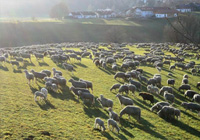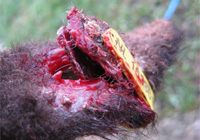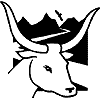Individual Electronic Identification of Sheep & Goats - a threat to extensive farming

Electronic Identification (EID) is yet another example of EU rules that are driving traditional, extensive livestock farmers out of business. These rules are unnecessary and fail to take account of farming realities. As with the EU rules on permanent pastures they are bad for farmers, bad for the environment and of no benefit to society.
High Nature Value farming is above else the use of semi-natural pastures by extensively-managed livestock. If we want to keep those biodiversity benefits, we have to think of the viability of low-intensity farming systems.
Nowadays, most of those surviving semi-natural pastures are low-productivity grasslands, heaths and scrublands, most of them in Europe's uplands. The animals best suited to the poorest of those pastures are sheep and goats. Today these very sheep and goat systems are facing a severe threat from EU regulations on animal identification; rules that ironically were brought in response to the problems in intensive farming.

Being able to trace the movement of animals is essential for disease control and should, if implemented honestly, allow the public to be confident about the source of their food. For many years it has been possible to trace a piece of lamb from the butcher back through the slaughterhouse to its holding of birth via any other farms on which the animal lived. The need for this flock-based traceability is beyond doubt; it has been in place for many years.
However, as a result of the Foot and Mouth disease outbreak in the UK in 2001, the EU has brought in a requirement not only to identify each individual animal, but to do so electronically by means of special ear tags, boluses or similar devices. This Electronic Identification (EID) is now in force and is a severe threat to low-intensity sheep and goat producers.
The problems are many:
- Cost - An electronic tag costs around €1; an old-style tag about one tenth of that amount. On top of that is the cost of the chip reader, the software and, for some farmers, the computer (farmers who don't use computers are unimaginable to the bureaucrats) and of course the extra hassle and work. To put these costs into perspective, the gross margin per ewe on Blackface flocks in NW Scotland in 2011 was only €11 and the net margin, -€25 (QMS data).
-
 Cruelty - Electronic tags are heavier than their non-electronic predecessors. They often lead to damage to the ear. The need to have individual identification, made 'secure' through the use of a tag in each ear means that if one is lost, in practice the other has to be cut out and replaced as well; as well as imposing unnecessary suffering (counter to EU rules!), there are examples of short-eared animals literally 'running out of ear'! More information on these aspects can be found in this presentation by Shetland vet, Hilary Liebeschuetz.
Cruelty - Electronic tags are heavier than their non-electronic predecessors. They often lead to damage to the ear. The need to have individual identification, made 'secure' through the use of a tag in each ear means that if one is lost, in practice the other has to be cut out and replaced as well; as well as imposing unnecessary suffering (counter to EU rules!), there are examples of short-eared animals literally 'running out of ear'! More information on these aspects can be found in this presentation by Shetland vet, Hilary Liebeschuetz. - Impossibility of perfection - Initially it was said that 100% functionality was essential (that is, after all, the logic, such as it is, of the measure). Now a certain margin for error is deemed acceptable, though tests in the UK show that the fail rate increases every year. On top of this however, are the unavoidable constraints imposed by the farming system - 100% gathers are often impossible; tags are not used in the optimum conditions recommended by the manufacturer, but often in cold and wet conditions.
- Unfair link to financial support - Any failing in the tagging, whether due to lost tags, imperfect gathers, equipment error, is a breach of the rules; cross-compliance means that farmers who claim support get penalised. This may be fair for a system where there is a realistic expectation of perfect compliance - it is not fair in the case of EID in extensive systems.
- Unfair competition between sectors - Only sheep and goat producers have to face mandatory individual electronic identification; their competitors in the beef sector, usually on better land, have only individual non-electronic ID, in the pig sector - much more intensive and much more of a threat to human health - herd ID is deemed sufficient. Extensive sheep flocks are self-contained - only the rams are bought in; to inflict high cost on the systems which pose least biosecurity threats is nonsensical, wholly unjust and, importantly, pointless.
- Unfair competition between countries - The EU law allows countries with small national flocks to exempt themselves from the rules. However, disease threat is not related to numbers, but to other factors such as density and the intensity of production. If EID is not needed for intensive flocks in one country, why is it needed in extensive flocks in another? This unfairness is at the heart of a German case currently before the European Court of Justice.
These practical difficulties for the individual farmer make no sense when neither individual identification nor EID adds anything to the safety of flocks or the traceability of food for the consumers. But they also raise ethical issues, questions about how government should interact with farmers, questions which have a wider resonance for our society.
- Loss of trust - it is in extensive farmers' interest to maintain biosecurity and to ensure that their high quality products are traceable to their well-maintained landscapes and well-managed flocks, but they know better than bureaucrats what is practical and workable and gives the best results.
- Vested interests -The only people who clearly benefit from EID are the chip and software companies; their self-interested lobbying is behind its imposition. Farmers don't want to be their subcontractors, dependent on them for their support payments.
- Industrialisation of farming culture - Extensive farming retains a strong culture and a large body of traditional knowledge - it is the opposite of a faceless industry. While the consumer professes to appreciate that, Government insists that computerisation, with living animals becoming just things numbers, is the future for 'the industry'. Traditional farmers don't agree.
These moral questions lie at the heart of a recent protest in the south-east of France. The 'protest transhumance' has received considerable media coverage and is the subject of a film and a blog in French. You can read here translations of a blog article and a press release by the Confédération Paysanne.
Back to news overview


